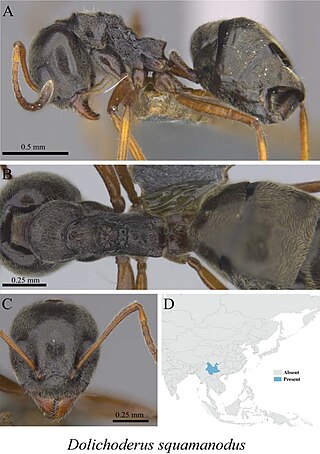
Dolichoderinae is a subfamily of ants, which includes species such as the Argentine ant, the erratic ant, the odorous house ant, and the cone ant. The subfamily presents a great diversity of species throughout the world, distributed in different biogeographic realms, from the Palearctic, Nearctic, Afrotropical region and Malaysia, to the Middle East, Australian, and Neotropical regions.

Lufengosaurus is a genus of massospondylid dinosaur which lived during the Early Jurassic period in what is now southwestern China.

Sinopterus is a genus of tapejarid pterodactyloid pterosaur from the Aptian-age Lower Cretaceous Jiufotang Formation of Chaoyang, Liaoning, China. It was first described and named by Wang Xiaolin and Zhou Zhonghe. Historically, there were multiple species attributed to the genus although only one is considered to be valid. Sinopterus is known for its proportionally large skull, which has a birdlike pointed beak, a long bony crest that starts with a tall premaxilla and goes back along the middle of the skull to form a point overhanging the rear of the skull, and its lack of teeth.

Dolichoderus is a genus of ants found worldwide.
Dolichoderus affinis is a species of ant in the genus Dolichoderus. Described by Emery in 1889, the species is endemic to various countries of Asia.
Dolichoderus brevicornis is a species of ant in the genus Dolichoderus. Described by Dlussky in 2002, remains of the species were discovered in the Baltic Amber.

Dolichoderus feae is a species of ant in the genus Dolichoderus. Described by Carlo Emery in 1889, it is endemic to multiple countries, notably China, India, Myanmar (Burma) and Thailand.
Dolichoderus flatidorsus is a species of ant in the genus Dolichoderus. Described by Zhou and Zheng in 1997, the species is endemic to China.
Dolichoderus incisus is a species of ant in the genus Dolichoderus. Described by Xu in 1995, the species is endemic to China.
Dolichoderus jiaoyanshanensis is an extinct species of ant in the genus Dolichoderus. Fossils containing the species were found in China, and it was described by Hong in 1985. The ant is from Shanwang and is presumed to be a Miocene insect.

Dolichoderus kinabaluensis is a species of ant in the genus Dolichoderus. Described by Dill in 2002, the species is endemic to Borneo.
Dolichoderus lacinius is an extinct species of Miocene ant in the genus Dolichoderus. Described by Zhang in 1989, fossils of a queen specimen were found in China.

Dolichoderus longipilosus is an extinct species of Eocene ant in the genus Dolichoderus. It was described by Dlussky in 2002, and the fossils of the species are only known from a fossilised worker that was found in the Baltic amber.
Dolichoderus pastorulus is a species of ant in the genus Dolichoderus. Described by Dill in 2002, the species is endemic to Borneo.
Dolichoderus pilosus is a species of ant in the genus Dolichoderus. Described by Zhou and Zheng in 1997, the species is endemic to China.

Dolichoderus squamanodus is a species of ant in the genus Dolichoderus. Described by Xu in 2001, the species is endemic to China.

Dolichoderus taprobanae is a species of ant in the genus Dolichoderus. Described by Smith in 1858, the species is endemic to Asia.

This timeline of oviraptorosaur research is a chronological listing of events in the history of paleontology focused on the oviraptorosaurs, a group of beaked, bird-like theropod dinosaurs. The early history of oviraptorosaur paleontology is characterized by taxonomic confusion due to the unusual characteristics of these dinosaurs. When initially described in 1924 Oviraptor itself was thought to be a member of the Ornithomimidae, popularly known as the "ostrich" dinosaurs, because both taxa share toothless beaks. Early caenagnathid oviraptorosaur discoveries like Caenagnathus itself were also incorrectly classified at the time, having been misidentified as birds.

This timeline of pterosaur research is a chronologically ordered list of important fossil discoveries, controversies of interpretation, and taxonomic revisions of pterosaurs, the famed flying reptiles of the Mesozoic era. Although pterosaurs went extinct millions of years before humans evolved, humans have coexisted with pterosaur fossils for millennia. Before the development of paleontology as a formal science, these remains would have been interpreted through a mythological lens. Myths about thunderbirds told by the Native Americans of the modern Western United States may have been influenced by observations of Pteranodon fossils. These thunderbirds were said to have warred with water monsters, which agrees well with the co-occurrence of Pteranodon and the ancient marine reptiles of the seaway over which it flew.
Shuangbaisaurus is genus of theropod dinosaur, possibly a junior synonym of Sinosaurus. It lived in the Early Jurassic of Yunnan Province, China, and is represented by a single species, S. anlongbaoensis, known from a partial skull. Like the theropods Dilophosaurus and Sinosaurus,Shuangbaisaurus bore a pair of thin, midline crests on its skull. Unusually, these crests extended backwards over the level of the eyes, which, along with the unusual orientation of the jugal bone, led the describers to name it as a new genus. However, Shuangbaisaurus also possesses a groove between its premaxilla and maxilla, a characteristic which has been used to characterize Sinosaurus as a genus. Among the two morphotypes present within the genus Sinosaurus, Shuangbaisaurus more closely resembles the morphotype that is variably treated as a distinct species, S. sinensis, in its relatively tall skull.










